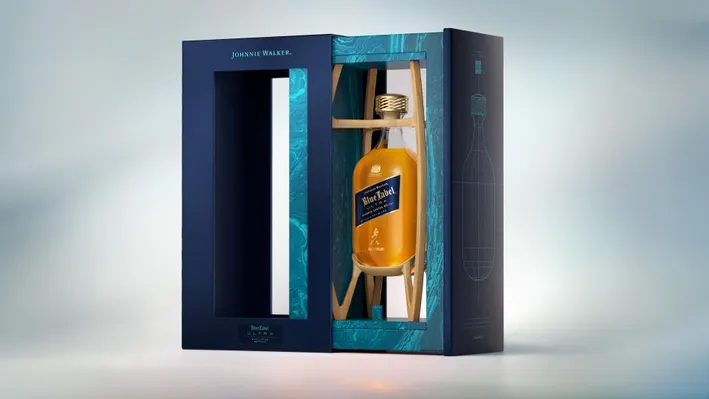Johnnie Walker, a brand synonymous with excellence and innovation in the whisky industry, has recently unveiled a groundbreaking addition to their prestigious Blue Label line—the Blue Label Ultra, housed in what they claim is the world’s lightest whisky glass bottle. Weighing only 180 grams (without the cap) and with a capacity of 700 milliliters, the bottle represents a significant leap in the intersection of luxury packaging and sustainability. It is the result of five years of experimentation, aiming to provide a more sustainable and eco-friendly solution for the high-end spirits market.
This launch is a bold statement by Johnnie Walker, signaling the brand’s commitment to reducing its environmental footprint while maintaining the premium image that whisky enthusiasts and collectors have come to expect from Blue Label. The Blue Label Ultra bottle is more than just a lighter vessel for their famed whisky; it is a reflection of the broader industry’s push towards sustainability. Yet, while Johnnie Walker’s innovative approach is commendable, it also raises important questions about balancing luxury with environmental responsibility.
The Innovation Behind the Bottle Design
The Blue Label Ultra’s packaging is the result of a long-term effort to challenge the traditional norms of luxury spirits packaging. Johnnie Walker’s design team sought to reimagine the bottle by significantly reducing its weight without compromising the elegant design that defines the Blue Label range. The 180-gram bottle weighs significantly less than the average whisky bottle, which typically weighs between 400 to 700 grams, making it an industry leader in terms of lightweight glassware.
From a technical standpoint, reducing the weight of glass bottles presents numerous challenges. Glass must still maintain its structural integrity, provide adequate protection for the liquid, and retain an element of elegance. Johnnie Walker’s ability to achieve this while using less material is a testament to the brand’s commitment to innovation. The new bottle retains the sleek, angular shape that is characteristic of Johnnie Walker bottles, ensuring that it remains recognizable and luxurious, despite the reduction in weight.
The development of this bottle demonstrates how luxury brands can adapt to meet modern challenges, particularly in sustainability. Traditional luxury packaging, known for its heavy, substantial feel, has long been associated with quality and exclusivity. However, Johnnie Walker’s Blue Label Ultra bottle redefines what consumers can expect from high-end spirits, proving that sustainable practices can be integrated into the luxury sector without sacrificing the opulence and prestige that connoisseurs value.
Sustainability Meets Luxury: A Delicate Balance
Johnnie Walker’s decision to focus on sustainability is reflective of a larger trend in the spirits and luxury goods industries. As consumers become more environmentally conscious, there is increasing pressure on brands to demonstrate their commitment to reducing waste, lowering carbon footprints, and adopting eco-friendly practices. In response, many companies, including Johnnie Walker, have taken steps toward using recyclable materials, reducing packaging waste, and minimizing their environmental impact.
The Blue Label Ultra bottle represents a bold attempt to address these concerns, but it also raises questions about how brands like Johnnie Walker can balance sustainability with the high standards of luxury that their customers expect. Traditionally, luxury goods have been synonymous with excess—excess in materials, design, and presentation. Heavier bottles, ornate packaging, and elaborate details have long been seen as markers of exclusivity. By contrast, the Blue Label Ultra’s lighter, more minimalistic approach is an interesting departure from these conventions.
In reducing the weight of the bottle, Johnnie Walker must walk a fine line between sustainability and maintaining the premium nature of their brand. The Blue Label range has long been regarded as one of the most prestigious in the world of whisky, and much of that prestige is tied to the sensory experience of the bottle itself—the way it feels in the hand, the weight it carries, and the sense of grandeur it conveys. Consumers may wonder whether the lighter bottle detracts from the luxurious experience they’ve come to expect, or whether the commitment to sustainability enhances the overall appeal of the product.
The Consumer Response: Sustainability as a Selling Point
In recent years, consumer attitudes toward sustainability have shifted significantly. Luxury brands, including those in the spirits industry, are finding that eco-friendly practices are not only expected but also appreciated by a growing segment of the market. The introduction of Johnnie Walker’s Blue Label Ultra bottle aligns with this shift, positioning the brand as a leader in the sustainability movement within the whisky industry.
For environmentally conscious consumers, the Blue Label Ultra is likely to be a welcome innovation. The reduction in material usage and weight not only lessens the environmental impact of production and shipping but also signals that Johnnie Walker is serious about its role in addressing global sustainability challenges. The use of less glass means fewer resources are consumed during the manufacturing process, and the lighter bottles result in lower fuel consumption during transportation, further reducing the product’s carbon footprint.
However, there is always a question of how far luxury consumers are willing to go in their pursuit of sustainability. While the eco-conscious consumer may appreciate the environmental benefits of a lighter bottle, others may still associate weight and heft with quality and exclusivity. In this sense, the success of the Blue Label Ultra will depend in part on how well Johnnie Walker communicates the value of this innovation. The brand must ensure that consumers see the reduced weight not as a compromise, but as a forward-thinking advancement that preserves the essence of the Blue Label experience while responding to modern concerns.
A Future for Sustainable Luxury Packaging?
Johnnie Walker’s Blue Label Ultra sets an important precedent for the future of luxury spirits packaging. As more brands begin to adopt sustainable practices, the challenge will be to maintain the sense of luxury that consumers expect while minimizing the environmental impact of packaging. The Blue Label Ultra bottle is one of the first examples of a luxury brand making a significant shift toward sustainability without sacrificing the core elements of their identity.
Looking ahead, the spirits industry will likely see an increasing number of brands following Johnnie Walker’s lead. As the demand for sustainable products grows, luxury brands will need to innovate in ways that align with consumer values. For Johnnie Walker, the Blue Label Ultra bottle is a step in the right direction, offering a glimpse into how the industry might evolve in response to environmental concerns. It shows that sustainability does not have to be at odds with luxury—in fact, the two can complement one another when approached thoughtfully and creatively.
At the same time, this innovation invites broader questions about the future of packaging in the luxury market. Will lighter, more sustainable materials become the norm, or will brands continue to cling to traditional notions of what luxury packaging should be? Johnnie Walker’s success with the Blue Label Ultra will undoubtedly influence the direction other brands take, and its reception will serve as a barometer for how well the industry can balance tradition with innovation.
A Bold Move for Johnnie Walker
With the introduction of the Blue Label Ultra, Johnnie Walker has once again positioned itself at the forefront of the whisky industry, not only in terms of the quality of its product but also in its approach to packaging and sustainability. The world’s lightest whisky glass bottle is a testament to the brand’s commitment to innovation, environmental responsibility, and luxury.
As the spirits industry continues to evolve, Johnnie Walker’s bold move to reduce its environmental footprint while maintaining the elegance of its Blue Label range is a blueprint for others to follow. The Blue Label Ultra is more than just a lighter bottle—it is a symbol of how luxury brands can embrace sustainability without compromising the values that have made them iconic. This is a critical moment for the whisky world, and Johnnie Walker has set a new standard for what the future of luxury packaging could look like.
No comments yet.







